To: Kurt.Mueller@plexus.com
Sent: Friday, September 19, 2003 7:38 PM
Subject: Re: removing
Kurt,
I see it a bit differently. Instead of working on a better way to remove the drivepoint, I would first work on a way to prevent the pipe from breaking. I agree with you that the problem is most likely that you are running into rocks. When the drivepoint comes into contact with a rock, it makes a different sound - sort of a dull thud rather than the usual ping. Also, it doesn't go down. When you hear the dull thud and see it isn't going down,
stop immediately. Failure to do so can cost you hundreds of dollars in equipment.
But don't abandon the hole. Use an auger with an extension to turn the stone, then reinsert the drivepoint and continue. Are you using drivepoints with cast iron tips? If not, Supermike (his email identity) at Utica Pump Company in Utica, NY tells me they sell for $52 each (plus shipping). Where are the breaks occuring? Are they in the pipe or in the couplings? If the breaks are occuring at the couplings put a collar on the drivepoint. A collar expands the hole a little bit which keeps the fittings from catching on the edges of the hole. If the pipe breaks just below the surface, it is not always necessary for you to pull the point. Dig a hole and expose the broken end of the pipe. Clean the end and file off any burrs. A section of 1 1/2 inch Schedule 40 galvanized pipe should fit snugly over a broken 1 1/4 inch Schedule 40 galvanized pipe. There are a number of ways to join them together. If you choose to arc weld, be careful because the fumes can be toxic.
Sincerely,
Fred Dungan
----- Original Message -----
From: "
El Lobito"
To:
fdungan@fdungan.com
Sent: Tuesday, January 29, 2002 12:24 AM
Subject: Sandpoint well.
Hi Fred,
I came across your site by miracle. I haven't had much luck in
finding any information about sandpoint wells. My parents' home has a
sandpoint well and it seems like it may of gone dry. I am planning to
see how difficult it is to install another sandpoint well myself. I
just wanted to take the time out to thank you for making this information
available. I was wondering if there are any more tips or things I should
take into consideration with a sandpoint well. I will point out that
is the only source of water for my parents' home.
Thanks for your time.
Cuco Anaya
el_lobito@onebox.com - email
From:
Fred Dungan
To:
El Lobito
Sent: Tuesday, January 29, 2002 5:35 PM
Subject: Re: Sandpoint well.
Cuco,
As a writer, I've had to learn how to get by on a shoestring budget. If it were my well and it went dry, I would get out my hammer and drive it a few feet deeper. Of course, there is a chance that it won't go any deeper or that the wellscreen will be damaged. But that is what I would do before going to the expense of putting in a new well. What have you got to lose?
Best regards,
Fred
From: Tim Howard
To: Fred Dungan
Sent: Tuesday, February 05, 2002 8:53 AM
Subject: RE: Wellscreens:
Fred,
Sorry about yet another intrusion, but when it comes to screen "opening" (mesh size), I'm assuming that smaller is better in that fewer particles get in the pipe. Is this accurate?
Thanks,
TJH
From: Fred Dungan
To: Tim Howard
Sent: Tuesday, February 05, 2002 6:20 PM
Subject: Re: Wellscreens
Dear Tim,
It is never an intrusion. This is what I do.
The size of particles varies with the aquifer. Where I live the subsoil is decomposed granite down to the bedrock - particles larger than a grain of sand. But if you expect to encounter grit or silt, it is best to go with a fine mesh. The larger particles in the aquifer lodge up against the wellscreen and act as a barrier to smaller particles. What this means is that the more a well is pumped, the cleaner the water gets.
But that really wasn't a direct answer, was it? That's because one is never absolutely certain what size mesh to use, but when in doubt, the odds are better if you go with a fine mesh. The biggest problem with fine mesh is that as it corrodes, the flow reduces. That is why I recommend going with a stainless steel wellscreen (brass is second best).
Sincerely,
Fred Dungan
From:
Peter Schmied
To: fdungan@fdungan.com
Sent: Monday, March 04, 2002 6:54 PM
Subject: Well question (from your article)
Fred,
What function does the polyethylene tubing serve, and what do you hook up to each end?
Your article was a great resource for me, thanks a lot.
Peter Schmied
Florida
From:
Fred Dungan
To:
Peter Schmied
Sent: Monday, March 04, 2002 8:37 PM
Subject: Re: Well question (from your article)
Dear Peter,
Thanks for reminding me that I need to alter my website to indicate that the tubing is optional. The next time you visit you will find the changes have been made.
The tubing, when attatched at one end to a foot valve, constitutes the simplest (only one moving part) and most reliable (I've used it every day for 11 years), manual water pump for BOTH shallow and deep small diameter water wells. It's called an inertia pump and the best part about it is that it is foolproof. Even when exposed to direct sunlight (I live on the edge of the Mojave Desert where it is not unusual for the temperature to soar above 110 degrees in summer) and subjected to sand and muck that would cause most pumps to fail, it keeps on pumping. However, being manually operated, it requires sweat equity and is not for everyone.
My original intention was to design an inexpensive method (under $500) of obtaining groundwater at depths of up to 80 feet for use in underdeveloped nations. The idea was to make it so simple that local labor could be utilized for installation and so durable that it would not require any maintenance. I succeeded far beyond my wildest dreams. However, when I attempted to give it to the United Nations for free, I ran up against a consortium of drilling interests who did not appreciate me interfering with their lucrative contracts.
You most likely have access to electricity and would prefer the convenience of a powered pump. However, if you have any difficulty
in clearing sand and dirt from a new well, you might consider using an inertia pump, as they are faster, cheaper, and infinitely more reliable than the bladders and bailers that are currently being used for this purpose.
Sincerely,
Fred Dungan
From: Nord, Russ (MED, LUNAR)
To: fdungan@fdungan.com
Sent: Tuesday, May 28, 2002 2:02 PM
Subject: Well (what else?)
Fred,
I just found your website and read thru it with a great deal of
interest. Especially the question and answer section. You may be able
to help me decide what to do with my home well.
I don't want to make a new well, I want to recondition the one we have.
It's somewhere on the order of 50 years old, a driven sand point
according to the man who built the house. It's in our basement and goes
down only 15 feet below the floor, again according to the builder. The
problem is that it's gotten very slow. I don't think the water table
has changed, so I assume that the point has clogged up. I've heard of
reconditioning a well by dropping in some kind of acid tablets; I've
heard of pumping water in and out to re-position the sand grains; I've
even heard of "shooting" a well with a .22 rifle. What words of wisdom
do you have on this?
Russ Nord
Ft. Atkinson, WI
From: Fred Dungan
To: Nord, Russ (MED, LUNAR)
Sent: Wednesday, May 29, 2002 9:35 PM
Subject: Re: Well (what else?)
Russ,
I would rate the risk in the following order:
1. compressed air
2. chemicals
3. bullet
Let's take a worse-case scenario and say that you somehow put a large hole in the well screen. At least it is no longer clogged. Drop a smaller diameter Schedule 40 pipe with an inexpensive PVC drivepoint on one end down the inside of your well and you will have a slightly smaller, but more efficient well. However, this is a last resort. I would first try the compressed air and the acid.
As for the bullet....
Sincerely,
Fred Dungan
From: Hebert, Tim
To: fdungan@fdungan.com
Sent: Tuesday, March 26, 2002 7:39 AM
Subject: Well Pump Testing
Dear Fred,
I am purchasing a home with a well. I would like to know how I can
test the gpm's on my own without hiring a contractor.
Regards,
Tim Hebert
From: Fred Dungan
To: Hebert, Tim
Sent: Tuesday, March 26, 2002 5:23 PM
Subject: Re: Well Pump Testing
Tim,
Get yourself several 5 or 10 gallon containers. Run the pump full blast for 2 minutes and fill the containers with the water. Use the second hand on your watch to mark the time. When done, count up the number of gallons that you have and divide by two. This will give you a rough estimate of gallons per minute. However, when evaluating the quality of a well, most people consider the recovery rate to be every bit as important as the rate of flow. Recovery rate is how long it takes the well to come back up to the normal level when you pump it down. You might also want to evaluate the quality of the water. Does it smell funny? How does it taste? If in doubt, you can send a sample to a laboratory. I would also check around the plumbing fixtures inside the house. Are there heavy mineral deposits or stains? If so, you might want to ask the seller to take into consideration that you will need to purchase a water softener.
Best regards,
Fred Dungan
From: "Allen Borlaug"
To: "Fred Dungan"
Sent: Monday, April 22, 2002 4:31 PM
Subject: Well location
Dear Fred,
I was in luck and found your article on the net. I just bought a piece
of proprerty in north Iowa and hope to install a sand point well. A new
drilled well was just put in across the road from my property and the
log of well is as follows:
0' to 9' topsoil, brown clay
9' to 20' Blue clay
20' to 45' Sandy blue clay
45'to 83' Blue clay
83' to 85' Limerock
85' to 101' Shale
101' to 118' Limerock
118' to 120' Shale
What kind of educated guess could you give me at the chances of finding
water based on this log? There is a sand point well that has worked
well about 1/4 mile down the road on the other side of a small stream.
Thank you for your trouble.
Sincerley yours,
Allen Borlaug
From: Fred Dungan
To: senatorb@powerbank.net
Sent: Monday, April 22, 2002 7:37 PM
Subject: Re: Well location
Dear Allen,
You are obviously one of those rare individuals who take the time and trouble to do the research before embarking upon a project. The well log definitely tells a tale from which you may benefit.
Let's begin with a bit of inside info on the business of drilling. It is standard practice in the drilling industry to go down at least 100 feet regardless of how much water may be bypassed at a shallower depth. The purpose of this is twofold - #1 it helps to justify the enormous cost (because the drilling rig costs upwards of $100,000, the contractor often charges thousands of dollars simply to set up his equipment at the site) and #2 the deeper the well, the less chance that it will go dry during seasonal fluctuations or droughts.
Now, let's move on to an analysis of the well log. I am surprised that the contractor did not note the depths and flow rates of any water encountered at shallower depths. Of course, it is possible (but not likely) that he did not encounter water until he reached the second layer of shale. But if he did, it would have been on top of the blue clay or limerock. I suggest that you go visit the sand point well and find out how deep it is as there is a good chance that you will find water at about the same level on your property. Don't attempt to punch through blue clay or limerock with a drivepoint as such strata is almost impossible to penetrate without a drilling rig.
Wishing you success,
Fred Dungan
From: Martin, Michael D MMC(SS) (CSS16 N405) MartinMD@css16.navy.mil
To: fdungan@fdungan.com
Sent: Tuesday, April 29, 2003 11:57 AM
Subject: Wells
Mr. Dungan,
I sent you an E mail on the website but I wasn't sure it went thru. I passed
a little history on but let me cry on your shoulder some more. I am a Senior
Chief in the USN ( Sorry ) I see how proud you are on your son, I hope this
fiinds him well. I have a home in the hills of North Ga and have been having
a heck of a time keeping my wife happy and at 10$ a foot things are getting
pricey. As I said I have had 3 drilled on 5 acres, closest is appx 200 apart
farthest is 500 feet, all are 600 or greater and have had hydro fractures on
all. I think two of them will eventually fill but i have no idea for sure.
The driller told me they were about two GPM but after a month we pumped them
dry. My psi tank is only 5 gal and I read that you recommend a large tank to
accomodate the slow recharge. I think the route I would like to take is to
set up my shallow well. The one I mentioned in the other mail, and pump down
my drilled well till it loses suction then let it recharge and see how long
it takes to fill ?? My shallow well is down the road on another piece of
property about 500 yards down the street. It is 18' deep 36" dia and holds
5 feet of water. If pumped dow to 6" it will recharge 3 feet in 1 hr. I can
see water filling it as soon as I stop pumping so I think it will be ok. ???
How about you??
Dean
----- Original Message -----
From: Fred Dungan
To: "Martin, Michael D MMC(SS) (CSS16 N405)"
Sent: Tuesday, April 29, 2003 10:43 PM
Subject: Wells
Dean,
My father was a career Navy man, a Chief Quartermaster who served in World War II and Korea. His last ship was a heavy cruiser, the USS Helena. I was born in the US Naval Hospital at 7th and Bellflower in Long Beach, California. Our base housing was a big quonset hut, which sure beat the little trailer without a bathroom that we lived in before then.
I'll tell you a secret, but first you must promise to spread it far and wide. Drillers have an enormous investment in their rigs, some of which cost upwards of a quarter of a million dollars. Their crews make good money. In order to recoup his investment and justify what he charges the customer, it is to a driller's advantage to go as deep as possible, often bypassing better aquifers than the one he will eventually tap into halfway to Hades. And that deeper than deep well will cost you even more in the long run because it will require more electricity to raise the groundwater to the surface.
More and more property owners are turning to do-it-yourself water well alternatives. That is what me and my website, Water Well Helpline, are all about. I show people like yourself how they can do the job for less. In your case, if you would prefer not to go to the expense of purchasing a larger pressure tank, you can accomplish pretty much the same thing by enlarging the diameter of your well. The larger the diameter, the more water it holds. Needless to say, an underground reservoir is less cumbersome and a heck of a lot cheaper than purchasing a pressure tank. However, I should mention that the pressure tank does have an advantage in that it takes some of the strain off your pump and thereby makes it last longer.
Sincerely,
Fred Dungan
Sent: Thursday, June 20, 2002 8:38
AM
Subject: OLD WELL
DEAR FRED,
I LOVED THE WEB SITE AND WAS GLAD TO
HAVE SOMEONE TO ASK A FEW QUESTIONS TO.
I HAVE AN OLD WELL. APPROX 20 FT
DEEP. AND WATER AT 17' OR SO. THE WELL HAS A THIN WALL 4" PVC IN IT NOW.
SO I PUT IN A JET PUMP WITH 1.5" PVC DOWN LINE AND IT WOULDN'T BRING ANYTHING
UP. AS IT TURNS OUT THE 4' PVC IN THE WELL IS BROKEN UP AT THE BOTTOM
AND JUNK IS IN IT. A FRIEND SAID TO PUT AN AIR LINE IN THE WELL AND
"BLOW " THE WELL. HE SAID THE AIR WOULD CREATE AN AIR POCKET THAT WHEN IT
BURST WOULD SHOOT MUD AND SMALL JUNK OUT THE WELL AND, AFTER A DAYS OR SO,
CREATE A SAND CAVITY.
2 QUESTIONS.
1, WILL THE COMPRESSED AIR WORK TO
MAKE A CAVITY?
2, IF I PUT A SMALLER (3") PVC PIPE
INSIDE THE OLD 4" FOR A NEW WALL, OR DOES IT HAVE TO BE SEALED OFF FROM THE
OLD WELL WALL TO WORK.
THOMAS TIDWELL
SOUTH EAST TEXAS
GULF
Thomas,
Any job worth doing is worth doing right. Your well has
muck in the bottom. Remember, this is your drinking water we are talking
about. If there is a company nearby that pumps out septic tanks, ask them
if they also do wells. Otherwise you will have to do it the hard
way. Get rid of that 4 inch thinwall and replace it with either
Schedule 40 or Schedule 80 PVC.
The compressed air idea might work. Then again, it might
not. Your friend may well be a genius, but in this
case genius could be a liability.
Best regards,
Fred Dungan
From: Randall Reihing
To: fdungan@fdungan.com
Sent: Friday, August 16, 2002 10:20 AM
Subject: Point Well
Dear Mr. Dungan:
Researching information on point wells because mine failed last night, I
came across your name. Hoping you might have time for a reply. My wife and
two daughters will appreciate it almost as much as I will. Women who cannot
shower are almost as frustrated as those with insufficient closet space.
Unfortunately I now have all three. No water, not enough closet space, and
three frustrated and upset women. Only the dog is sympathetic. He could
care less and is currently a better friend than I knew.
Every August, for the past four years, our 1979 point well seems to run
out of water and we lose the pump prime. If we are not home, the pump runs
until it fails. We thought we had a defective check valve or something
related to that, so last year the entire system, above ground, was rebuilt
with new pipes, new check valve and a new Wayne 3/4 hp motor and associated
jet pump. It worked perfectly flowing some 2-3 gpm at 25-40 psi for the
past year.
Last night, the pump turned on. For some reason the water pressure had
dropped and never recovered.
We will need a new pump again. I am now wondering if the point is
defective. I opened the top of the 1-1/4" casing and dropped a weighted
string down. Hit water at about 8'. The string reached 15' before it
stopped moving.
I have had several people at our small town's hardware tell me the 1979
point is most likely corroded and to just "wash-in" a new point. "It's
simple" they say - "just takes a few hours". But the local well driller
wants $2500.00 to do that. And $4500.00 for a drilled well. So, I am
considering replacing the point myself. But, I have not been able to locate
detailed information on step-by-step instructions for "washing in" a point
well. Can you help?
Hoping you might have time to reply.
Sincerely,
Randall Reihing
From: Fred Dungan
To: Randall Reihing
Sent: Friday, August 16, 2002 6:47 PM
Subject: Re: Point Well
Randall,
At least you still HAVE a woman. Mine left 20 years ago and I have yet to find a replacement. Out of desperation, I have become one of those people who talk to dogs. No wonder the neighbors look at me funny.
It sounds like you have a bad case of seasonal fluctuation. The symptoms are that the water table drops every August and leaves you with no water. Yes, there is water in the pipe, however, the recovery rate (how long it takes the pipe to refill) isn't worth a plug nickel. Ordinarily, I'd tell you to take the pump off, screw on a cap, and give it a couple of whacks with a sledgehammer to drive it a few feet deeper. However, considering how long it has been in the ground, that is probably not a good idea. The alternative, of course, is to put in a new well. But that, too, doesn't make much sense, considering that the well you already have works most of the time. So here is what I recommend: put down a new well next to the old well and go at least seven feet deeper (but not deeper than 25 feet because that is the limit for suction pumps) and hook both wells up in series (join the pipes at the top and use one pump to pump both wells). Put in a ball valve that will allow you to shut off the old well at times when it isn't producing. If this doesn't make the women happy, point them in the direction of my place. After a day with me, they will learn that there are worse things in life than having to do without a shower.
Sincerely,
Fred Dungan
---- Original Message -----
From: rkwood@mwt.net
To: fdungan@fdungan.com
Sent: Saturday, May 29, 2004 6:27 AM
Subject: Simple well question
How do you know for sure that you have driven your well deep enough? I was told
to drive it in 10ft, fill with water and if it stays go farther, keep going till
water no longer stays in pipe. Any validity to that? Going to attempt to install
a sand point soon. Thanks for any help. I have looked at your website and it's
very informative (printed all 38 pages), but found no info on this.
Ryan Woodhouse
From: "Fred Dungan" fdungan@sbcglobal.net
To: rkwood@mwt.net
Subject: Re: Simple well question
Date: Sat, 29 May 2004 22:30:40 -0700
Ryan,
I wasn't aware that my website had grown to 38 pages until I read your message. Back in 1997, when I started, it wasn't more than a page or two. Sometimes I worry that it has become too complicated. When I was in the Army, they used to tell us KISS (which is an acronym for Keep It Simple, Stupid). The more complicated I make it, the more likely it will confuse people instead of helping them.
When I was a little boy, my mother (who barely finished elementary school) told me that "water always seeks its own level." What she meant by it was that when two seperate bodies of water connect, it won't be long until they are both at the same level even if one was a lot higher than the other. If you fill the pipe with water, it is going to drain down to the aquifer's level shortly after the well screen encounters the aquifer. So, yes, the statement is valid. There are also a number of other good reasons for filling it up with water, the chief of which is that the water serves as a lubricant for the point - less friction makes less work.
Sincerely,
Fred Dungan
PHIL AND TRICIA WRITE ABOUT THEIR SANDSUCKER WELL
Date: Thursday, May 13, 1999 10:02 PM
Subject:
Driving a Well
Fred,
Thank you for your home page
section on driving your own well. I searched the internet for info when I
was interested in looking into it and your page was the only one out there on
the subject! I really used your encouragement to get me started. I
ended up doing what is called "Sand Sucking" my well to drive it down. I
started with an auger style post hole digger to get me down to the water table
(only about 20 feet here in Spring Lake). Then the hole keeps falling in
on itself when you finally hit water. At this point you send a 3" PVC pipe
down and begin "sand sucking" your 3" pipe down. The sand sucker is a pipe
that just fits into the 3" pipe. It is open at both ends with an upside
down funnel at the bottom. There is a steel ball in the pipe (the pipe is
about 2 1/2 feet long), that lets the sand and gravel in, but the water bubbles
out the top. You keep lifting the sand sucker up and down till it gets
some sand in it and then pull it up and empty it out. In the meantime, the
3" pipe tends to settle down farther and farther till you are as far below the
water table as you want to go. I hit water at about 20 feet and sucked my
3" pipe down to 29'. At this point, I placed a 2" PVC pipe with a 5' PVC
point attached into the 3" pipe and attached sections of 2" pipe until the point
was resting at the bottom of the well. Then I pulled the 3" pipe up to
expose the 2" PVC point (5 feet or more). Then you cut off the 3" and 2"
pipe at the surface and attach a pitcher pump to clean out the
well.
I am planning to use our well
for watering our lawn because I do not want to pay the city for its water.
I purchased a 1 1/2 horse jet pump. With a 1 1/2" pipe as output from the
jet pump I am getting 60 gallons of water per minute! This is PLENTY of
water for my little 100' X 150' lot. I am laying the automatic sprinklers
out this weekend.
I have attached a picture of
the well in progress. I am the one in the flannel shirt, the other is my
buddy Skip.
In the picture of my wife and Skip you can
see Skip holding the sand sucker. The 3" pipe is sticking up quite a ways,
too far in fact to work the sand sucker. We ended up cutting it off to a
managable 5' sections so we could work it from the ground rather that on the
ladder. Our dog Mango (a Jack Russell Terrier), is also in the
picture. She is going to love the sprinklers as she loves chasing
water...
Thanks again for your
information,
Phil & Tricia
DeVries
Spring Lake MI
The well has a flow rate of 60 gallons per minute and Phil says he can operate twice as many sprinklers at one time as his neighbors who depend upon the municipal system. If you have further questions, you can reach Phil and Tricia by clicking on the address at the top of the message. They live in Spring Lake, MI.
BUILDING A SAND SUCKER WELL - QUESTIONS AND ANSWERS
----- Original Message -----
Sent: Sunday, October 10, 1999 12:34 PM
I came across your article about your Sand Sucker
well. I am obviously researching the possibilities of putting in a well
myself. Unlike you I am in Georgia. There are wells everywhere here
so I am certain I will find water. Your article is very short and
raises a couple questions I hope you can answer for me.
1. Did you just auger down until you found wet
sand?
Yes. The water table here is at 20 feet. I augered and
kept adding 5' sections onto my auger until I hit the wet sand.
2. You
mentioned "At this point, I placed a 2" PVC pipe with a 5' PVC point attached
into the 3" pipe and attached sections of 2" pipe until the point was resting at
the bottom of the well." Could you give me some more info on this?
(i.e. is the 2" pipe glued into the 3" or just what?)
No, the 3" PVC pipe
is what I worked into the ground (down to 29') with the sand sucker. First
I augered a hole down to 20'. Then I placed the 3" pipe into the hole (I
pieced together two 10' sections and one 5' section to begin with). Then I
sand sucked the 3" pipe down to 29' (I added
one more 5' section when the end
of the pipe got down to ground level). The sand sucker simply fills up
with sand via the up-down motion you create by pulling it up and down by hand
with a rope you have tied to it. When it's full, you pull it up, empty it,
and repeat...). This allows the 3" pipe to 'jiggle' down, little by
little until it is at the depth you desire (typically so the top of your point
will be at least 4' to 5' below the water table) Then I placed the the 2"
pipe (with the 5' PVC point attached to the bottom of it) into the 3"
pipe. Now you have both pipes sitting in the hole. They are not
attached to each other in any way, simply one inside of the other with the 5'
point at the bottom inside the 3" pipe. The key is that you have to pull
the 3" pipe up. Pull it up 5' so that the 2" PVC point is fully exposed to
the ground (and water). Cut both pipes off at the top. Cut the 3"
pipe just about ground level, and cut the 2" pipe high enough above the ground
so you can attach your pump to it. The 3" pipe remains a part of your
well, although it is not used for anything other
than a head start if you
ever have to pull up the 2" pipe to service it.
3. Did you have to create
a filter pack and if so what did you use (gravel, sand, a
mixture...)?
No. The soil here is made up of sand and gravel
therefore no filter pack is necessary.
4. Where on the Internet did you
find any additional information you used? Things are still somewhat
limited.
You are correct, info is limited! I went to the local
hardware store where the owner helped me along (he had a sand sucker that he let
me borrow). I was convinced I could do it based on Freds page (the page
that has my info on it that you read). If you have soil made up of
sand/light gravel, then a sand sucker may work for you. Otherwise you
would probably be better off pounding down a steel point with 2" galvanized
pipe. You can still auger down a hole as far as you can; it will likely
reduce the work of pounding quite a bit. If you would like info on a sand
sucker, I can give you the name of the hardware store that I went to in
MI. He may be able to help you.
Thanks for any help you can
offer. A well will be great for my lawn and for emergency water in case
there is an outage. Yes, hurricane Floyd could have hurt us
bad!
Brent Cook
Hinesville, Ga.
WARNING: PVC drivepoints can shatter when hit with a hammer.
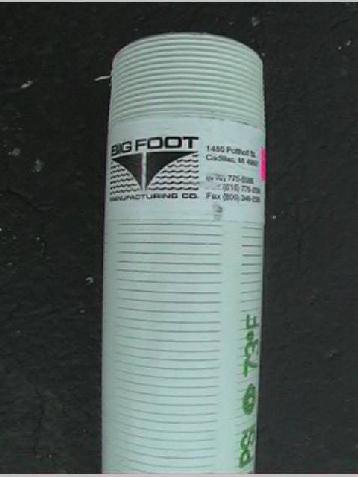
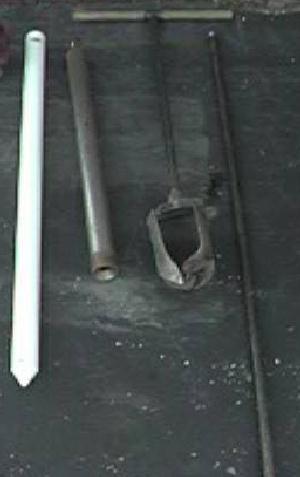
LEFT PHOTO: closeup of PVC drivepoint RIGHT PHOTO: left to right - drivepoint, sand sucker, auger, and auger extension
Fascinating isn't it? For more details, click on the photos. If you have access to a machine shop, you can build your own sandsucker by following Phil's diagram:
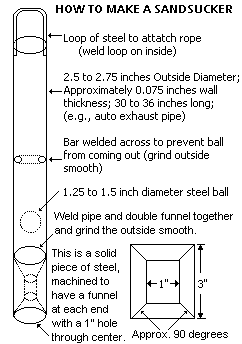 To view an enlargement click here. You will need Word '97 or or later to open it.
To view an enlargement click here. You will need Word '97 or or later to open it.

 fdungan@fdungan.com
fdungan@fdungan.com
 Return to home page.
Return to home page.
This page last modified on June 29, 2004.
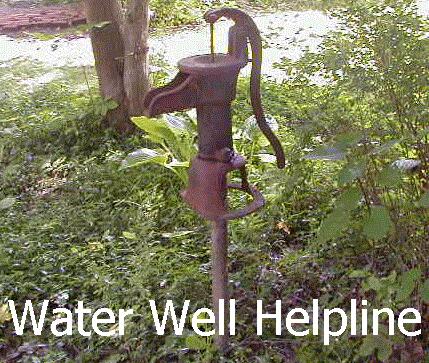
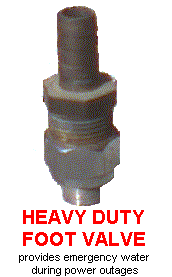 You'll need a 2-inch drivepoint with screen (a hollow, conically shaped metal point adjoined to a fine mesh screen), several spools of teflon tape, 2-inch galvanized couplings to attatch pipe lengths together, 5-foot-long threaded lengths of 2-inch galvanized Schedule 40 pipe, 2-inch galvanized caps for the pipe, concrete mix, a weight, a foot valve, and 85 feet of 1/2 inch inside diameter, thick-walled, flexible, UV resistant, flexible polyethylene tubing (I used Toro "funny pipe" irrigation tubing).
You'll need a 2-inch drivepoint with screen (a hollow, conically shaped metal point adjoined to a fine mesh screen), several spools of teflon tape, 2-inch galvanized couplings to attatch pipe lengths together, 5-foot-long threaded lengths of 2-inch galvanized Schedule 40 pipe, 2-inch galvanized caps for the pipe, concrete mix, a weight, a foot valve, and 85 feet of 1/2 inch inside diameter, thick-walled, flexible, UV resistant, flexible polyethylene tubing (I used Toro "funny pipe" irrigation tubing).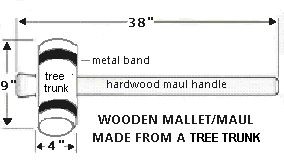 Hit the capped pipe as evenly as possible in the center of the cap and avoid side-to-side swaying of the pipe. A well-placed blow will make a dull sound rather than a ping. When the cap becomes cracked or dented, discard it and screw on a new one. Establish a steady rhythm and the work will go easier. When the cap is about even with the bottom of the pit, unscrew it and screw on a coupling and a new length of pipe. Use teflon tape on the pipe threads, and make certain all connections are tightened securely with a pipe wrench. You may occasionally need to work from a step ladder in order to reach the cap with the maul. When going through clay or shale, you may find it easier to use a sledgehammer, but be careful not to overdo it.
Hit the capped pipe as evenly as possible in the center of the cap and avoid side-to-side swaying of the pipe. A well-placed blow will make a dull sound rather than a ping. When the cap becomes cracked or dented, discard it and screw on a new one. Establish a steady rhythm and the work will go easier. When the cap is about even with the bottom of the pit, unscrew it and screw on a coupling and a new length of pipe. Use teflon tape on the pipe threads, and make certain all connections are tightened securely with a pipe wrench. You may occasionally need to work from a step ladder in order to reach the cap with the maul. When going through clay or shale, you may find it easier to use a sledgehammer, but be careful not to overdo it.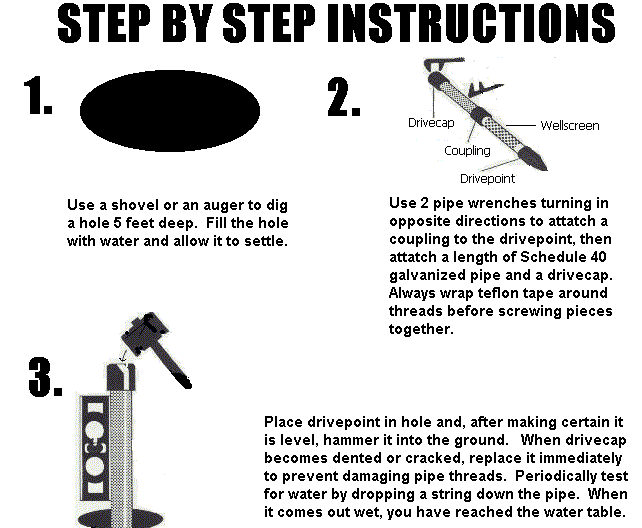
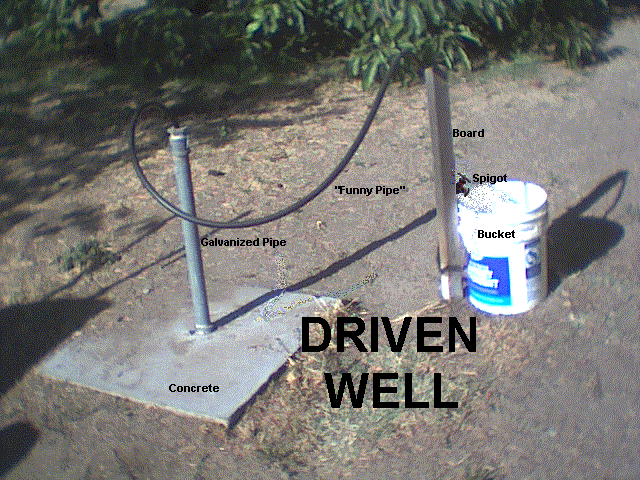
 one 2 inch diameter drivepoint with screen (from well supply dealer), $135
one 2 inch diameter drivepoint with screen (from well supply dealer), $135 two spools teflon pipe thread tape, $2
two spools teflon pipe thread tape, $2 fifteen 2-inch galvanized couplings, $68.70
fifteen 2-inch galvanized couplings, $68.70 fifteen 5-foot threaded lengths of 2-inch galvanized Schedule 40 pipe, $140
fifteen 5-foot threaded lengths of 2-inch galvanized Schedule 40 pipe, $140 five 2-inch galvanized caps, $14.45
five 2-inch galvanized caps, $14.45 two bags concrete mix, $6
two bags concrete mix, $6 one 2-ounce weight, $1
one 2-ounce weight, $1 one heavy-duty brass foot valve, $19 (optional)
one heavy-duty brass foot valve, $19 (optional)

 100 feet polyethylene tubing, sold by irrigation supplies dealers, $60 (optional)
100 feet polyethylene tubing, sold by irrigation supplies dealers, $60 (optional)Push the washers into the large end of the hose barb until they fit snugly (if they don't fit snugly, try using 3/8 or 3/8M washers). Wrap the male pipe threads with teflon tape. Place the 1/2 inch metal ball on top of the washers. Next, screw the two brass fittings onto each other. The device you put together is called a foot valve. If you assembled it correctly, the metal ball will rattle when you shake the valve.
I would then connect the injector to the pump at the surface. Since I was planning to lower the sandpoint, tail pipes, check valve, and injector, with pressure pipe completely assembled into the casing, I decided to use only high quality components that I was sure would withstand the driving. I wanted to get the jet as close to the water table as I could to minimize lift and maximize flow. I also wanted to use 1Ό rather than 2 pipe so that I could drive it as far as possible in hopes of getting the soft water we had at the other cabin nearby. For my purposes, water quality was more important than quantity.
Dug wells have been around since ancient times. The Old Testament twice mentions the well of Bethlehem, located by the city gate (Samuel 23:15 and 1 Chronicles 11:17). Many of these wells - some of which are still in use today - were dug at an incline with wide, elongated stone steps leading gently down to an underground chamber at the bottom of which there was a subterranean pool of water. Jars and pitchers were filled with water at the edge of the pool and balanced on the head on the way up. Such wells are only practical in arid climates where there is not much risk of contamination from surface runoff.
If you have municipal water and your monthly bill is more than you can afford to pay, you might want to consider switching to a drivepoint for your irrigation water. Where I live (Riverside County in Southern California), the county charges less for irrigation well permits than it does for potable water permits. Vegetable gardens, trees, flowering plants, and lawns often thrive on water that is less than pristine. Most sprinklers require at least 40 psi. The more pressure you can develop, the better. If you have a lot of sprinklers, you will need to build a manifold and purchase a station timer. Install a check valve just before the pump. This will prevent the water from draining back into the well when the pump is off. If the output of the pump is less than the volume of water required to run the sprinklers, a big enough pressure tank will make up the difference. Subtract the gallons of water that the pump produces from the number of gallons required by your sprinklers and the remainder is how big your tank should be.

 LEFT PHOTO: closeup of PVC drivepoint RIGHT PHOTO: left to right - drivepoint, sand sucker, auger, and auger extensionFascinating isn't it? For more details, click on the photos. If you have access to a machine shop, you can build your own sandsucker by following Phil's diagram:
LEFT PHOTO: closeup of PVC drivepoint RIGHT PHOTO: left to right - drivepoint, sand sucker, auger, and auger extensionFascinating isn't it? For more details, click on the photos. If you have access to a machine shop, you can build your own sandsucker by following Phil's diagram:fdungan@fdungan.com
Return to home page.